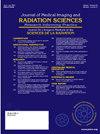Experiences of Zambian radiographers undertaking mammography
IF 2
Q3 RADIOLOGY, NUCLEAR MEDICINE & MEDICAL IMAGING
Journal of Medical Imaging and Radiation Sciences
Pub Date : 2025-09-30
DOI:10.1016/j.jmir.2025.102091
引用次数: 0
Abstract
Background
Mammography is an imaging technique that uses X-rays to create detailed breast tissue images, essential for the early detection of breast cancer and improved patient outcomes. In Zambia, radiographers develop their mammography skills mainly through on-the-job training, with experienced radiographers mentoring juniors to enhance their confidence and proficiency. This collaborative approach aims to improve breast cancer detection in the region.
Objective
Given the limited body of research on the experiences of radiographers in Zambia who perform mammography procedures, this study aimed to explore and describe the lived experiences of radiographers involved in mammography imaging within both private and public diagnostic radiography facilities in Zambia.
Participants and research setting/Methods
A qualitative phenomenological approach was adopted, employing purposive and snowball sampling strategies to recruit participants. Data were collected through semi-structured, one-on-one telephone interviews with diagnostic radiographers from four of the seven hospitals in Zambia that offer mammography services. A total of twelve interviews were conducted, with data collection continuing until data saturation was achieved. Ethical principles and trustworthiness criteria were rigorously observed throughout the study.
Results
The study’s findings revealed three main themes: (i) Lack of adequate training in mammography. This theme highlights the challenges faced by radiographers due to the absence of formalized and specialized training in mammography. (ii) Barriers to providing quality mammography. In this theme, participants identified several obstacles that hinder the delivery of quality mammography services. These include limited access to mammography equipment, a shortage of radiologists, and a lack of breast cancer education. (iii) Strategies for improving mammography services. This theme reflects the participants’ recommendations for enhancing mammography services in Zambia, including digital imaging technology, expanding clinical training opportunities for radiographers, and the establishment of a postgraduate training programme in mammography.
Conclusion
The study revealed important insights into Zambian radiographers' experiences with mammography, highlighting challenges that may lead to unnecessary procedures and difficulties in accessing services. It also identified opportunities to improve the quality and availability of these services.
赞比亚放射技师进行乳房x光检查的经验。
背景:乳房x线照相术是一种利用x射线创建详细的乳腺组织图像的成像技术,对于早期发现乳腺癌和改善患者预后至关重要。在赞比亚,放射技师主要通过在职培训来提高他们的乳房x光检查技能,由经验丰富的放射技师指导初级放射技师,以增强他们的信心和熟练程度。这种合作方法旨在提高该地区的乳腺癌检测。目的:考虑到赞比亚进行乳房x光检查的放射技师的经验研究有限,本研究旨在探索和描述在赞比亚私人和公共诊断放射检查设施中参与乳房x光检查成像的放射技师的生活经验。参与者和研究环境/方法:采用定性现象学方法,采用目的性和滚雪球抽样策略招募参与者。数据是通过半结构化的一对一电话访谈收集的,访谈对象是来自赞比亚提供乳房x光检查服务的七家医院中的四家的放射诊断技师。总共进行了12次访谈,数据收集一直持续到数据饱和为止。在整个研究过程中严格遵守道德原则和可信度标准。结果:研究结果揭示了三个主要主题:(i)缺乏足够的乳房x光检查培训。这一主题强调了由于缺乏正规和专门的乳房x光检查培训,放射技师所面临的挑战。提供高质量乳房x光检查的障碍。在这一主题中,与会者确定了妨碍提供高质量乳房x光检查服务的几个障碍。其中包括获得乳房x光检查设备的机会有限,放射科医生短缺,以及缺乏乳腺癌教育。改善乳房x光检查服务的战略。这一主题反映了与会者对加强赞比亚乳房x光检查服务的建议,包括数字成像技术,扩大放射技师的临床培训机会,以及建立乳房x光检查研究生培训计划。结论:该研究揭示了赞比亚放射技师在乳房x光检查方面的重要经验,突出了可能导致不必要程序和获得服务困难的挑战。它还确定了改善这些服务的质量和提供的机会。
本文章由计算机程序翻译,如有差异,请以英文原文为准。
求助全文
约1分钟内获得全文
求助全文
来源期刊

Journal of Medical Imaging and Radiation Sciences
RADIOLOGY, NUCLEAR MEDICINE & MEDICAL IMAGING-
CiteScore
2.30
自引率
11.10%
发文量
231
审稿时长
53 days
期刊介绍:
Journal of Medical Imaging and Radiation Sciences is the official peer-reviewed journal of the Canadian Association of Medical Radiation Technologists. This journal is published four times a year and is circulated to approximately 11,000 medical radiation technologists, libraries and radiology departments throughout Canada, the United States and overseas. The Journal publishes articles on recent research, new technology and techniques, professional practices, technologists viewpoints as well as relevant book reviews.
 求助内容:
求助内容: 应助结果提醒方式:
应助结果提醒方式:


